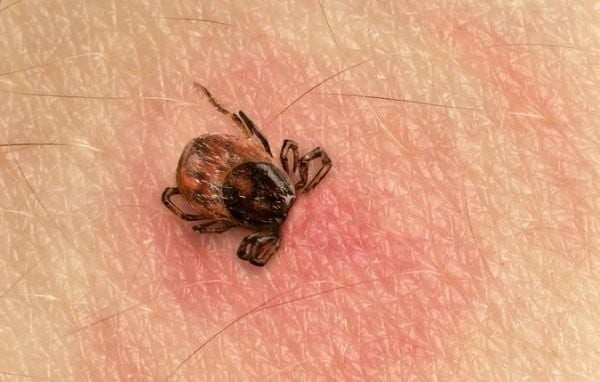On August 30, Specialist Doctor Le Thi My Chau - Department of Internal Medicine, Tam Anh General Hospital, Ho Chi Minh City said that Ms. Bui Thi Sot (Dong Nai) was taken to the hospital for emergency care a week ago.
In the emergency room, the patient was unconscious. The doctor measured his vital signs and found that his blood pressure was low and his blood oxygen level had dropped to about 93%. The patient was immediately transferred to the ICU (Intensive Care Unit), given a strong dose of systemic antibiotics, and regained consciousness.

Many cases of the disease become severe, causing the patient to go into shock and organ failure due to tick fever.
Previously, Ms. Sot went to many large hospitals for examination and was diagnosed with an infection of unknown origin. She was given medication and sent home to self-monitor. However, her fever, fatigue, and pain did not improve.
Doctor Chau said that after examination, he discovered that Mrs. Sot had an ulcer under the crease of her chest - a typical sign of tick fever. Asked about her medical history and the epidemic area, the patient said that there was a garden around her house, and she often went to the garden to clean the rambutan garden.
The tick is a parasite Orientia tsutsugamushi, which lives on ticks and is often found in densely wooded areas. Patients with tick fever often have symptoms of prolonged fever (fever above 37.5 degrees Celsius, lasting more than 7 days), swollen lymph nodes, muscle pain, headache, cough, digestive disorders... The main characteristic of tick fever is ulcers on the skin in areas such as the genitals, buttocks, legs... (because ticks usually only jump 20 - 30 cm high). It is very rare for ulcers to appear on the upper body.
Diagnosing the patient with scrub typhus, Dr. Chau decided to stop using conventional antibiotics. The patient was given an intravenous antibiotic specifically for treating scrub typhus.
Immediately after taking the medicine, the patient recovered quickly, the fever stopped, and blood oxygen levels and blood pressure gradually stabilized. After 7 days of treatment, the patient was alert, ate normally, and was discharged from the hospital.

Doctor Chau checks the patient's health before discharge. (Photo provided by the hospital).
Dr. Chau added that tick fever is a common disease in areas with many trees. Patients often live, work, and move around in gardens and fields, where there are many ticks and may have the parasite Orientia Tsutsugamushi living on them.
Tick fever can be self-limiting after 3-4 weeks. However, in many cases, the disease becomes severe, causing the patient to go into shock, organ failure such as kidney failure, liver failure, increased liver enzymes, etc. Many cases require mechanical ventilation and dialysis.
Doctor Chau recommends that if patients discover skin ulcers accompanied by symptoms of prolonged fever, body aches, cough, fatigue, jaundice, yellow eyes, etc., they should go to the hospital for timely examination and treatment.
Thu Phuong
Source


![[Photo] General Secretary To Lam receives Chief of the Central Office of the Lao People's Revolutionary Party](https://vphoto.vietnam.vn/thumb/1200x675/vietnam/resource/IMAGE/2025/5/30/140435f4b39d4599a3d17975dfb444c5)
![[Photo] Journalists moved to tears at the Memorial Service for the soldiers who died in Gac Ma](https://vphoto.vietnam.vn/thumb/1200x675/vietnam/resource/IMAGE/2025/5/30/9454613a55c54c16bf8c0efa51883456)

![[Photo] A delegation of 100 journalists from the Vietnam Journalists Association visits the soldiers and people of Truong Sa island district.](https://vphoto.vietnam.vn/thumb/1200x675/vietnam/resource/IMAGE/2025/5/30/0984a986227d4e988177f560d2e1563e)

![[Photo] National Conference "100 years of Vietnamese Revolutionary Press accompanying the glorious cause of the Party and the nation"](https://vphoto.vietnam.vn/thumb/1200x675/vietnam/resource/IMAGE/2025/5/30/1cf6cd5c8a934ebfa347028dcb08358c)





![[Video] Vietnam strives to master the technology to produce 15 types of vaccines by 2030](https://vphoto.vietnam.vn/thumb/402x226/vietnam/resource/IMAGE/2025/5/30/9b660538f5aa46daaff8b19dc9ca8204)











































































Comment (0)